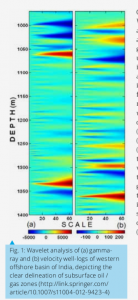
Our group specialises in the field of geophysical signal analysis. We have been working on implementation of novel signal analysis techniques such as wavelet transform, multifractal and empirical mode decomposition analyses to a variety of geophysical signals of diverse origins. These techniques help unravel the hidden information from the signals that cannot in general be possible to obtain with conventional signal analysis tools. The group maintains a library of all the software indigenously developed in Matlab, C, C++ and C# languages for the above techniques. They also have developed a GUI for multifractal analysis of non-linear geophysical data. While wavelet analysis was applied to geophysical well-log data to delineate the depths to the oil/gas zones in the subsurface (Fig. 1), empirical mode decomposition analysis (EMDA) (Figs. 2a, 2b) and multifractal detrended fluctuation analysis (MFDFA) (Fig. 2c) techniques were applied to well-log data sets to quantify the degree of heterogeneity in the subsurface, vis-à-vis their oil / gas potential. Besides applying these techniques to signals originating from within the Earth, our group has also applied them to geophysical signals of extra- terrestrial origin, such as geomagnetic field variations and ionospheric total electron content (TEC) data. In their recent study, they have characterised the TEC data at regional scales, corresponding to different solar activity periods using MFDFA (Fig. 3).
Currently our group is actively pursuing:
■ Development of machine learning techniques, such as Convolutional Neural Networks (ConvNets or CNNs) for predictive multifractal modeling of TEC data and seismological data at global and/or regional scales to characterise subsurface heterogeneity, as a part of the big-data initiative.
■ Development of wavelet-based approaches for multifractal analysis, such as wavelet leaders (WL) for effective characterisation of nonlinear geophysical signals.
Our goal is to establish a state-of-the-art Geophysical Signal Analysis Lab at the department of Earth Sciences, IIT Bombay. We welcome joint collaborations from various national and International research institutes and universities towards achieving these goals.
Prof. E Chandrasekhar
